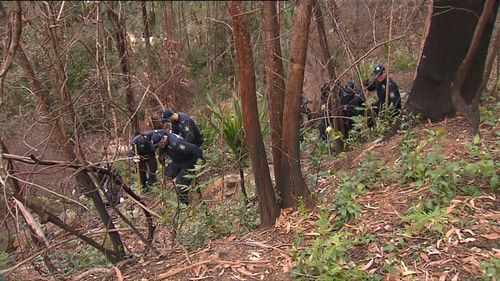
[ad_1]
Human remains were discovered in Sir Bertram Stevens Drive, in the Royal National Park in Sutherland on September 22, 2018. At the time, a post-mortem examination determined that the remains were that of a man, however police were unable to determine any further characteristics.

Now, new DNA phenotyping technology only used 10 times to date in NSW has enabled detectives to form a picture of what the man looked like, assisting police in solving the mystery behind who the victim was and how he died.
An examination by a forensic anthropologist confirmed all of the bones found belonged to the same skeleton, and that the man was about 175cm tall and aged between 25 and 40 at the time of his death.
Police said the body may have been inside a bag, “potentially for decades” before being discovered in 2018. The bones were then sent for DNA phenotyping – a process of predicting a person’s appearance based on parts of their DNA that control how we look – to identify the likely ancestry of the person, along with their hair and eye colour. The results suggested a high probability that the bones were that of a man of Asian descent, with brown eyes and black hair.

“Our team use the DNA found on skeletal remains to create a picture of what the person would have looked like; including characteristics such as hair and eye colour, as well as geographic ancestry,” NSW Health Pathology Executive Director, Michael Symonds said.
“This type of testing is helping investigators provide families of missing persons with answers that may not have been possible without these advanced forensic capabilities.”
Homicide Squad Commander, Detective Superintendent Danny Doherty said the new technology was becoming an increasingly important part of solving crimes and providing closure to families searching for loved ones still missing.
“Remember this was a bag of bones found in bushland, it was exposed to weather and at the time fire ravaged the area in the royal national park, and we don’t want that person remembered like that,” Det. Supt Doherty said.

“This was a person who was walking around with likes in food, music, someone’s son, someone’s friend or associate and that’s why we’re here, to identify that person and work out what happened to that person.” Bomb pulse carbon dating tests were then undertaken by the University of Waikato, New Zealand, revealing the man died sometime between 1985 to 2005.
Police were then able to cross check the appearance with 565 men identified as long term missing persons. Detectives are now tasked with locating families to obtain DNA samples for comparison, which police believe will be the key to solving the mystery.
“We’re here to appeal to people who may not have reported their loved on missing because we still haven’t identified the remains,” Det. Supt Doherty said. “It has been a hugely collaborative effort with our partnering agencies to get us to this point, where we know the likely age, ethnicity and select details of this man’s physical description.
“We realise that we are casting a broad net in relation to identifying this man, but we would strongly encourage anyone who has a loved one that is missing that fits this description to contact police.”
“It’s a still a mystery as to who the person is and what happened to them.
“We’re hopeful we can get a match form DNA from the family but if we don’t, we’re back to square one.”

Research coordinator for NSW Police, Dr Jennifer Raymond said DNA phenotyping requires a high quantity and quality of DNA however she was confident the results from the recent tests were accurate.
“It can be really difficult to get DNA from degraded remains .. in some cases it’s just not possible,” Dr Raymond said.
“But they have managed to track down DNA from ancient remains hundreds of years ago so it is possible.”
Police have been unable to determine how the man died however the circumstances are being treated as suspicious.
[ad_2]
Source link